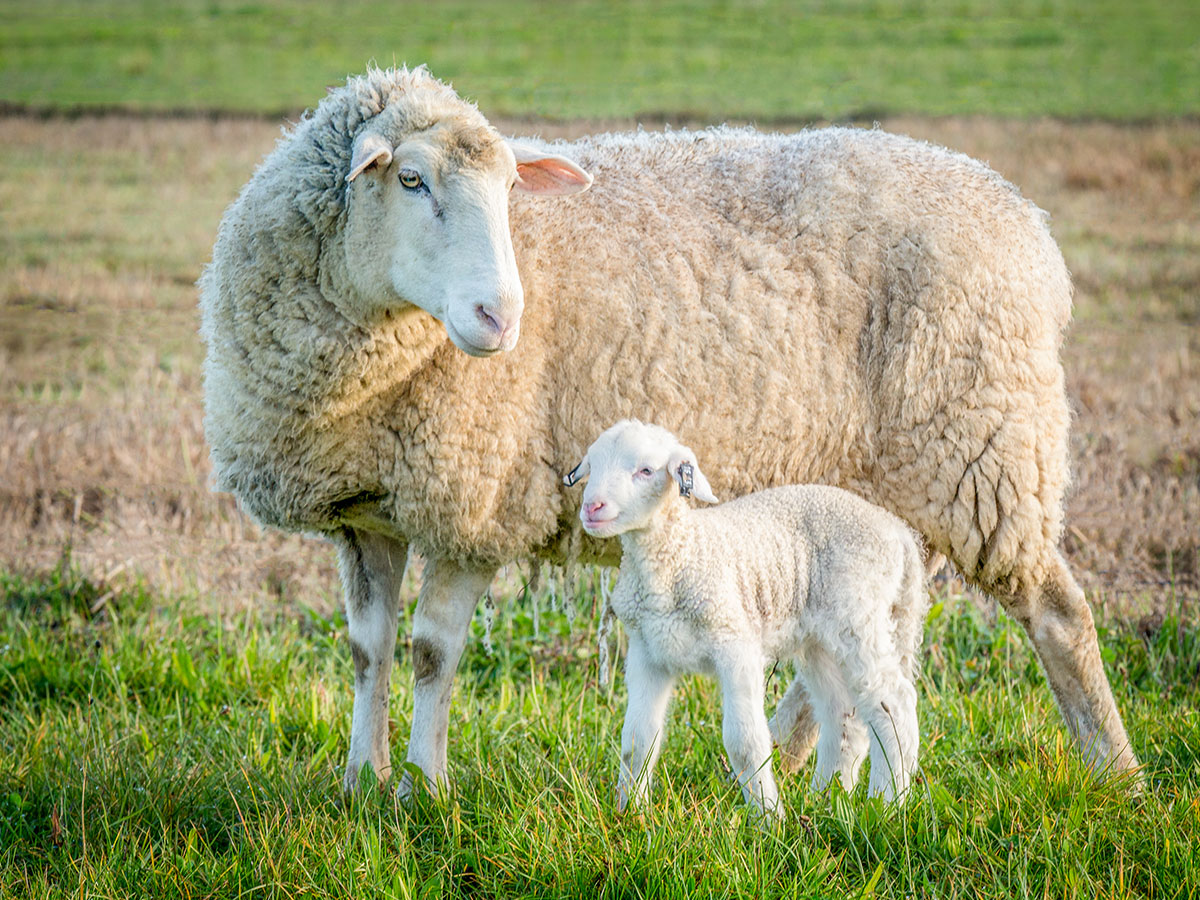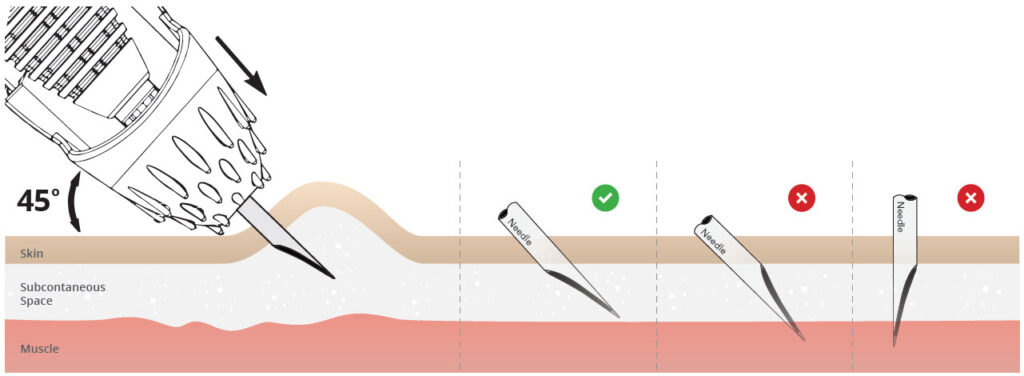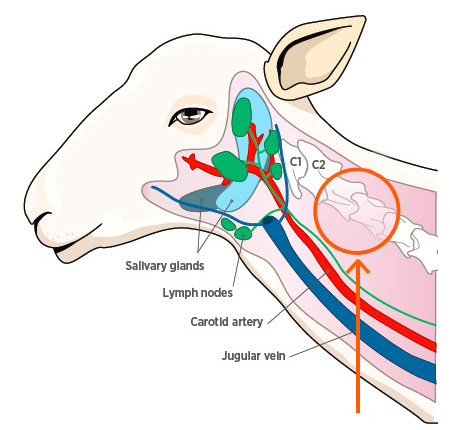Understanding Vaccination and Immunity
Protecting your flock from diseases that cause health and welfare issues involves a coordinated flock health program. A key component of most health programs is a strategic vaccination plan. In order to achieve the maximum level of protection a vaccine can offer; it is important to have a basic understanding of how vaccines function and how the immune system responds to a vaccine.
When an animal from a flock that has not been exposed to a specific pathogen (disease-causing agent) first comes into contact with a pathogen, it cannot generate an immune response quick enough and will be susceptible to the disease. If conditions in the animal are suitable, the immune system will suppress the disease and over time will recover from infection. If an animal recovers from disease, specific cells in the immune system (antibodies) are programmed to remember and recognise parts of that specific pathogen known as antigens. An antigen is anything the body identifies as foreign or not part of itself such as a bacteria or virus. The body recognises these antigens as a threat, stimulating the development of antibodies which work to protect the body from the bacteria or virus.
How Vaccines Work
Vaccines expose an animal to a specific pathogen, misleading the body into thinking it has encountered the actual bacteria or virus, therefore creating memory cells for the antigens belonging to that specific pathogen. The body is then able to recognise when it is under attack from the same pathogen and will generate a quick response before the pathogen can cause disease and will therefore develop immunity.
Vaccines generally fall into two categories, live or killed vaccines.
Live Vaccines
Live vaccines include a small amount of bacteria or virus that has been modified so it does not cause clinical disease. The virus or bacteria in the vaccine can sometimes replicate in the body, supplying the vaccinated animal with a mild form of the disease to stimulate life-long immunity. Live vaccines usually require a single dose providing longer lasting immunity than killed vaccines. However, live vaccines have a short shelf life and must be used as soon as mixed on farm.
Live vaccines should only be considered on properties where the disease is an issue. If animals from an uninfected property are vaccinated, this will introduce the virus on to the property. This may then require the establishment of a vaccination program to protect future stock, resulting in unnecessary costs to the producer.
Killed Vaccines
Killed vaccines are the most common form and do not require on-farm mixing and have minimal risk to pregnant animals. Most vaccines of this type require two doses. The first dose stimulates the antibodies, however, the level produced is often small and protection generally only lasts a few weeks before immunity declines, hence a second vaccination is required to boost immunity (Figure 1). An annual booster every 12 months following is generally recommended to ‘top-up’ the immunity levels against a specific pathogen or disease.
Why Vaccinate?
There are numerous sheep vaccines commercially available. Common diseases of sheep such as clostridial diseases, scabby mouth and ovine Johne’s disease (OJD) can cause significant economic losses and animal welfare concerns. However, some of these common diseases can be prevented by vaccinating. Points to consider before introducing a vaccination program include:
- Flock health history and the frequency of a particular disease in your flock.
- Disease occurrence in your area.
- Management practices increasing risk of disease such as supplementary feeding and marking.
- Sheep handling and vaccine storage facilities.
- Personal capability of correctly administering vaccines.
It is strongly recommended you consult with your local vet or animal health advisor before carrying out a vaccination program.
General Vaccine Principles
General principles to consider when vaccinating sheep include:
- Follow all handling and storage instructions as directed on the product label.
- Check the expiry date on the vaccine. Do not use if it is out of date.
- Ensure vaccination equipment is clean and in good working order.
- Ensure needles are sharp and clean. Discard any blunt needles during the vaccination session.
- Blunt needles should be handled with caution and discarded into a container before disposal.
- Ensure that the correct dosage is calibrated according to label specifications.
- Make sure vaccine is kept cool and out of the sun during long vaccination sessions.
- Subcutaneous vaccines (under the skin) should be given high on the neck just behind and below the base of the ear. The orange circle on the sheep anatomy diagram (Figure 3) indicates the correct site to vaccinate about 5 cm below the base of the ear, under the skin, on the side of the neck, avoiding critical structures.
- Subcutaneous vaccines should be injected under the skin, not into the skin or into the muscle. Always use a 6mm (1/4 inch) needle for subcutaneous injections in sheep. Longer needles will damage the carcass.
- Sheep should be adequately restrained to limit head movement while injecting.
- To inject, lift a fold of loose skin with your free hand, and inject into the ‘tented’ skin (Figure 2). This technique should not be used when vaccinating against OJD with Gudair® (refer to Vaccinating against OJD below).
- The needle should not pass through the fold of skin.
- If you are unsure if an animal has received the full dose, inject again.
Vaccinating Against Clostridial Diseases And CLA
Clostridial diseases including pulpy kidney, blackleg, black disease, tetanus, malignant oedema and swelled head in rams are caused by the bacteria, Clostridium. The bacteria can live in the environment for long periods of time. A clostridial vaccination program is recommended for all flocks.
Clostridial diseases are usually fatal and treatment is generally not viable. Clostridial diseases can be prevented using 5 in 1 vaccines, protecting animals against the five most common types of clostridial diseases. However, a 6 in 1 vaccine is strongly recommended, protecting against clostridial diseases as well as CLA (caseous lymphadenitis or cheesy gland). Cheesy gland causes abscesses in the lymph glands, decreased wool production and is a major cause of carcass condemnation and decreased carcass value at slaughter. Cheesy gland is easily preventable with the use of 6 in 1 vaccine. There is also a 7 in 1 vaccine (GlanEry 7in1 B12) newly available which protects against Erysipelas Arthritis as well as CLA and the 5 Clostridial diseases.
There are vaccines providing additional nutrients such as vitamin B12 and the trace element selenium as well as offering disease protection. Selenium deficiency and white muscle disease is common among lambs. When choosing selenium boosted vaccine, check that the vaccine contains the right amount of selenium for a lamb or adult dose. If lambs are given too much selenium it may poison them and if pregnant ewes are given a lamb dose then the insufficient dosage will not protect their lambs against white muscle disease. Vaccines that contain selenium should only be considered in selenium deficient areas. Consultation with your local vet or animal health advisor is recommended before commencing a clostridial vaccination program.
Things to consider when carrying out a vaccination program for clostridial diseases include:
- Vaccination is to be given subcutaneously.
- When starting the vaccination program, a course of two doses is required to stimulate immunity.
- The first dose should be given at lamb marking.
- Second dose should be given 4 to 6 weeks later or at the time of weaning.
- A single booster every 12 months is required for previously vaccinated sheep to maintain an adequate level of immunity.
- Annual booster should be given 4 to 6 weeks prior to lambing to ensure immunity is passed onto the lamb via the colostrum. New-born lambs should have adequate protection for up to 6-8 weeks, until lamb marking.
- If using a 6 in 1 or 7 in 1 vaccine, ensure that a booster has been given within 6 months of shearing to provide sufficient protection against cheesy gland.
- Sheep that have not been previously vaccinated or if the vaccination history is unknown should be vaccinated.
Vaccines registered for use include:
- Ultravac® 5in1 (Zoetis Animal Health)
- Glanvac® 6 B12 (Zoetis Animal Health)
- Glanvac® 6S (Zoetis Animal Health)
- GlanEry 7in1 B12 (Zoetis Animal Health)
- Websters® LV 5 in 1 (Virbac Australia)
- Websters® LV 5 in 1 with Se (Virbac Australia)
- Websters® 5 in 1 with Vitamin B12 (Virbac Australia)
- Websters® LV 6 in 1 (Virbac Australia)
- Websters® LV 6 in 1 with Se (Virbac Australia)
- Cydectin® Eweguard (Virbac Australia)
- Cydectin® Eweguard Se B12 (Virbac Australia)
- Cydectin® Weanerguard (Virbac Australia)
- Cydectin® Weanerguard Se B12 (Virbac Australia)
- Guardian 6 in 1 (Cooper’s Animal Health)
- Guardian 6 in 1 plus selenium (Cooper’s Animal Health)
- Tasvax 5 in 1 (Cooper’s Animal Health)
- Tasvax 5 in 1 plus selenium (Cooper’s Animal Health)
- Tasvax 8 in 1 (Cooper’s Animal Health)
Vaccinating Against Scabby Mouth
Scabby mouth is a very contagious viral disease of sheep and goats, causing reduced lamb body weights and mastitis in ewes. Treatment is not often viable, thus grazing management strategies and vaccination is the best method of protection against the disease. Scabby mouth vaccination is a prerequisite for some export markets.
Scabigard® (Zoetis Animal Health) is the only scabby mouth vaccine available in Australia. The live vaccine is commercially available from Zoetis or your local rural supplier. The vaccine generates life-long immunity by supplying the animal with a mild form of the disease. One vaccination will provide protection for life.
Vaccination should only be considered on properties where scabby mouth is an issue. If sheep from an uninfected property are vaccinated, this will introduce the virus on to the property. This may then require the establishment of a vaccination program to protect future stock, resulting in unnecessary costs to the producer.
General principles to consider when vaccinating include:
- When starting a vaccination program, all sheep and lambs should be vaccinated, to contain the spread of infection.
- Vaccinated animals can act as a source of infection for non-vaccinated.
- Lambs should be vaccinated at the time of lamb marking.
- Pregnant ewes should not be vaccinated within six weeks of lambing.
- Sterilising vaccination equipment before reuse. A specific applicator (Zoetis’ Scabigard® Applicator) is required to administer the Scabigard®
- This vaccine is different to other vaccines, as it has to be scratched into the skin. Most products require subcutaneous or intramuscular injection with a needle.
- Sheep need to be scratched on the bare skin inside the foreleg or side of the brisket to ensure a successful vaccine take. The scratch should be administered at a 45-degree angle to the skin, 4-5 cm in length and cause ample skin damage without drawing blood.
- The vaccine contains a blue dye, allowing the operator to see that the vaccine has been distributed along the entire skin scratch.
- Sheep or lambs must ‘take’ the vaccine to achieve adequate immunity against the disease. A successful vaccine ‘take’ is determined when animals display a line of pustules along the scratch line, one week following vaccination.
- Animals that fail to ‘take’ the vaccine should be revaccinated. Poor vaccination technique or improper storage and handling of the vaccine may lead to an unsuccessful ‘take’. Sheep that are already immune to the disease may fail to ‘take’ the vaccine.
- Antiseptics used in lamb marking should not be allowed to contaminate the vaccination site as this will destroy the vaccine.
- Immunity from the vaccine generally develops in two weeks.
- Care should be taken when vaccinating as Scabigard® is a live vaccine and scabby mouth is transmissible to humans. Seek medical attention if you scratch yourself with the vaccine.
- Contact your local vet for assistance on implementing an effective vaccination and control program.
Vaccinating Against OJD
Ovine Johne’s disease (OJD) is a chronic wasting disease of sheep, reducing the absorption of food, causing the animal to ‘waste away’ and eventually die. The disease can cause economic losses through inefficient productivity and reduced marketing options. Vaccination is a valuable tool in the prevention and control of OJD. Vaccinating against OJD is recommended for all Victorian flocks.
Zoetis Animal Heath’s Gudair® is the only vaccine available for the control of OJD in Australia. General principles to consider when implementing an OJD vaccination program include:
- Gudair® should be injected subcutaneously high on the neck just behind and below the base of the ear (Figure 1).
- Caution needs to be taken when vaccinating sheep, as the vaccine can have harmful side effects in humans if you inject yourself and don’t seek appropriate treatment.
- When vaccinating, the use of a specialised vaccinator such as SekurusTM is strongly recommended.
- A single dose of Gudair® provides life-long protection against the clinical development OJD.
- Lambs should be vaccinated between 4 and 16 weeks of age, ideally around marking time.
- Any introduced sheep should be vaccinated.
- All vaccinated sheep must be permanently identified with a ‘V’ tag.
- Consultation with a vet or product advisor is encouraged before carrying out an OJD vaccination program.
Vaccinating Against Erysipelas Arthritis
Erysipelas arthritis is common in newborn lambs and can also develop after management practices such as marking, mulesing and dipping. The causative bacterium enters the body through wounds such as shearing cuts or via the umbilicus of newborn lambs. The bacterium settles in the joints, causing inflammation. Erysipelas arthritis can cause serious production losses through poor growth rates, decreased wool production and general ill-thrift.
There are many different types of bacteria that can cause arthritis. Veterinary consultation is required to achieve an accurate diagnosis and appropriate treatment. Antibiotic treatment may be used in the early stages of Erysipelas; however it generally isn’t economically viable.
The best prevention is a combination of animal husbandry practices and an efficient vaccination program. Eryvac® (Zoetis Australia) is registered for the use against Erysipelas arthritis in sheep. General principles to consider when implementing an Erysipelas vaccination program include:
- Vaccination is to be given subcutaneously.
- When starting the vaccination program, a course of two doses is required to stimulate immunity.
- Previously unvaccinated ewes should be given their first dose at the time of joining followed by their second dose 4 weeks prior to the expected date of lambing.
- Previously vaccinated ewes should be given an annual booster 4 weeks prior to the expected date of lambing.
- If ewes are vaccinated at the directed time of year, immunity will be provided to the newborn lambs via the ewe’s colostrum for up to 8 weeks.
- Maintain a high level of hygiene when carrying out husbandry practices such as lamb marking and mulesing.
- Equipment should be disinfected and vaccinators boiled to sterilise.
Additional Management
To achieve the maximum benefit out of your vaccination program, most programs should be accompanied by strategic management practices depending on the disease you are vaccinating against. Management practices may include grazing strategies, nutrition management, animal husbandry procedures and biosecurity practices. For more information on biosecurity practices refer to the VFF biosecurity resource.
Further Resources
- See Pain Relief factsheet for more information
- AgVic
- DPIRD – Best practice lamb marking
- Zoetis – Lamb marking management
- FlyBoss – Tail length
Click here to download a PDF version.
For further information, please contact the VFF Stock Sense team on 1300 882 833 or by email [email protected]



